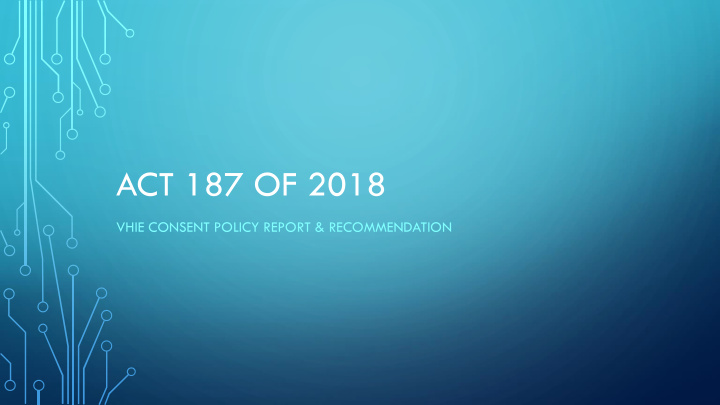



ACT 187 OF 2018 VHIE CONSENT POLICY REPORT & RECOMMENDATION
BACKGROUND • Act 73 of 2017 required the State to conduct a comprehensive review of the VHIE. The State engaged HealthTech Solutions (HTS) to conduct the evaluation. • Among the issues identified as a potential obstacle to the VHIE’s success was that the question of whether an individual’s health data would be accessible in the VHIE is determined through an opt-in consent policy that is administratively burdensome. • In 2017, the health records of only 19% of Vermonters’ were accessible in the VHIE. And along came Act 187. . . . .
ACT 187 Section 7 of Act 187 of 2018 provides: The Department of Vermont Health Access, in consultation with Vermont Information Technology Leaders, Inc., the Office of the Health Care Advocate, and other interested stakeholders, shall provide recommendations. . . regarding whether individual consent to the exchange of health care information through the Vermont Health Information Exchange should be on an opt-in or opt-out basis.
FIRST: WHAT DOES “OPT - IN” AND “OPT - OUT” MEAN? • “Opt - in” • Presumes that consent is withheld unless stated otherwise • For the VHIE this means a patient’s records are accessible only if a patient expressly indicates that “I want my records accessible” • “Opt - out” • Presumes that consent is granted unless stated otherwise • For the VHIE this means a patient’s records are accessible unless a patient expressly indicates that “I don’t want my records accessible” • Both approaches are recognized as valid mechanisms for capturing intent
RESEARCH SHOWS THAT VERMONT’S CONSENT REQUIREMENTS ARE UNUSUAL Survey of other states revealed that: • Vast majority of states have either opt-out consent or no consent requirement at all (only three states besides VT use opt-in). • All nine “Successful HIE Models” identified by HTS in its report used some form of opt-out. • There are different approaches to opt-out.
STAKEHOLDERS WEIGHED IN ON CONSENT • Vermont Information Technology Leaders, Inc. (VITL) • Office of the Health Care Advocate • GMCB • ACLU of Vermont • BiState Primary Care Association • Vermont Medical Society (VMS) • Vermont Association of Hospitals and Health Systems (VAHHS) • Medicaid and Exchange Advisory Board (MEAB) • Primary Care Advisory Board (briefly during HIE Plan “roadshow”) • DVHA HIE/HIT Steering Committee members
THE MAJORITY OF STAKEHOLDERS SUPPORT OPT-OUT • Significant majority of stakeholders support change to opt-out. • Supports patient’s preferences and increased accessibility of records • Reduces administrative burdens • Comfortable that patient privacy and autonomy are not degraded • Stakeholders opposing change voiced concern that privacy and autonomy may be degraded by opt-out. • ACLU Request careful roll-out if change in policy is adopted • Multiple instances of notice and publicity • Provider training • Rigorous implementation plan with ample time to opt-out before go-live
MOST VERMONTERS EXPECT THAT THEIR DATA IS EXCHANGED & OTHER CONSIDERATIONS • Security is not reduced by a change in the consent policy • Legislative (non)implications • Giving effect to the intent of most Vermonters
SECURITY WOULD NOT BE DEGRADED BY OPT-OUT • Existing security features of the VHIE are robust and meet or exceed all applicable requirements. • Changing the model of consent would have ZERO effect on HIE security. • No system safeguards would be altered in any way.
NO LEGISLATIVE ACTION WOULD BE REQUIRED • There is no Vermont statute that governs the issue of whether or what kind of patient consent may be required. • Some have argued that the Vermont “patient privilege” statute might be implicated. The Supreme Court of Vermont has clarified its proper scope. • The source of authority for the consent model at issue is a GMCB policy: Policy on Patient Consent for Provider Access to Protected Health Information on VHIE or through the Blueprint. • The GMCB can change this policy without legislative action.
96% OF VERMONTERS WANT THEIR RECORDS ACCESSIBLE VIA THE VHIE • Under Opt-in: • Of the 217,397 Vermonters asked, 95.2% want their records accessible in the VHIE by other providers who may have occasion to treat them. Records of 206,934 patients are accessible. • Approximately 63% of Vermonters have not been asked, in large part because of administrative burdens and costs associated with opt-in. None of their records are exchangeable using the VHIE. • Under Opt-out: • Records of approximately 2/3 of patients would be accessible. OPT- OUT BETTER REFLECTS VERMONTERS’ INTENT
PRELIMINARY RECOMMENDATION • Implement the overwhelming preference of interested stakeholders by revising the GMCB consent policy to provide for an opt-out consent model. • Take into account the perspectives of those who remain concerned by: • Making it easy to opt-out; and • Implementing the change with care to ensure that all who want out, are out.
DVHA WELCOMES ADDITIONAL STAKEHOLDER INPUT BEFORE ITS REPORT AND RECOMMENDATION IS SUBMITTED ON JANUARY 15.
NEXT STEPS • Incorporate feedback from this meeting into our analysis • Finalize our report and recommendation to legislative committees identified in Act 187
Recommend
More recommend